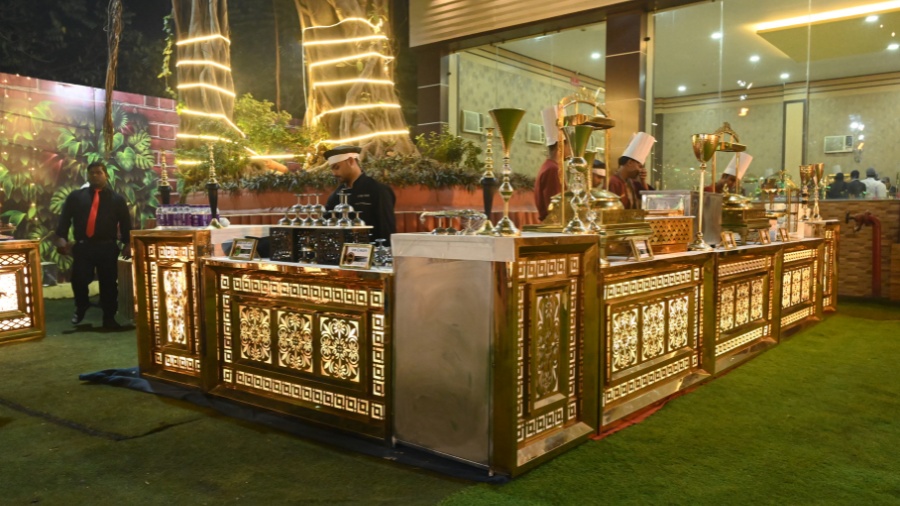Planning an event can feel like juggling flaming torches while blindfolded—especially when it comes to coordinating between your caterer and venue. Picture this: the perfect menu that dazzles your guests, paired seamlessly with a stunning location that sets the stage for unforgettable moments. But without effective communication and cooperation, even the best plans can go awry. In this blog post, we’ll explore essential strategies to ensure seamless coordination between your catering team and venue staff, making sure every detail is executed flawlessly on the big day. Get ready to transform potential chaos into harmonious celebration!
Introduction to the importance of coordination between caterer and venue for a successful event
The Role of Caterers:
Caterers are responsible for providing food, beverage, and service at events. They work closely with clients to create a customized menu that suits their needs and preferences. Not only do they prepare delicious food, but they also ensure that it is presented beautifully and served efficiently to the guests. In addition, caterers must also take into account any dietary restrictions or special requests from attendees.
The Role of Venues:
Venues provide the physical space for events to take place. They offer a variety of facilities such as banquet halls, conference rooms, outdoor spaces or even private residences. The choice of venue depends on the type of event being hosted and its theme. It is important for venues to understand all aspects of an event including its purpose, number of attendees, setup requirements, and other details in order to provide a suitable space.
Importance of Coordination Between Caterer and Venue:
Coordination between caterer and venue is crucial because they complement each other’s services. For instance, if an outdoor wedding reception is planned at a picturesque garden location provided by the venue then choosing light finger foods may be more appropriate than serving heavy meals which could inconvenience guests while exploring the beautiful surroundings.
Likewise, if an indoor corporate conference is held at a hotel convention center provided by the venue then choosing buffet-style catering might be more practical than plated service which requires tables for every single participant.
Furthermore, a well-coordinated team will eliminate any confusion or delays, ensuring that the event runs smoothly.
In addition, effective communication between caterer and venue is vital. Detailed discussions and site visits should take place in advance to understand each other’s requirements and limitations. For example, the caterer may need access to certain facilities or equipment provided by the venue for food preparation, while the venue may have restrictions on outside vendors that the caterer must adhere to.
Proper coordination between caterer and venue is essential for a successful event. It ensures that all aspects of the event align seamlessly and ultimately leads to a flawless experience for attendees. By understanding each other’s roles and working together as a team, caterers and venues can create an unforgettable event that leaves a lasting impression on guests.

Choose a Caterer Familiar with the Venue
When it comes to planning a successful event, one of the most important elements is the catering. The food served at your event can make or break the experience for your guests, so it’s crucial to choose a caterer that not only has great menu options but also has experience working with different venues.
One way to ensure smooth coordination between your caterer and venue is by choosing a caterer who is familiar with the specific venue you have chosen for your event. This means they have worked at the venue before and are familiar with its layout, facilities, and any potential challenges.
Firstly, a caterer familiar with the venue will have a better understanding of how to best utilize the space available. They will know where to set up their equipment, where to place dining tables, and how to create an efficient flow for serving food. This will save time and prevent any last-minute changes or delays that could disrupt the overall flow of your event.
In addition, a caterer who knows the venue well will be able to suggest creative ways to incorporate food into different areas of the event space. For example, if there is an outdoor area available for cocktails or appetizers, they may suggest creating food stations or setting up a mobile bar in that space. This can add an extra element of excitement and variety for your guests.
Furthermore, hiring a caterer familiar with the venue can also help avoid potential logistical issues such as limited kitchen access or restrictions on certain types of equipment. They will already be aware of any rules or regulations set by the venue and can plan accordingly in their menu options.
Having a rapport with both your caterer and venue staff can result in better communication and teamwork. This can lead to a smoother and more efficient event, with everyone working together seamlessly.
When selecting a caterer for your event, it is crucial to choose one who is familiar with the venue. Their knowledge can make a significant impact on the overall success of your event and ensure that all aspects of catering are flawlessly executed. Don’t be afraid to ask potential caterers about their experience with the venue before making a decision.

Schedule a Pre-Event Site Visit
One crucial step in coordinating between your caterer and venue for a flawless event is scheduling a pre-event site visit. This is an opportunity for both parties to familiarize themselves with the space and ensure that all details are aligned before the big day.
Schedule the site visit at least one month prior to the event to allow ample time for any necessary adjustments. It’s also important to have both the venue coordinator and caterer present during this visit so they can discuss logistical details together.
During the site visit, walk through each area of the venue that will be utilized for the event. This includes not only the main event space but also any outdoor areas, restrooms, kitchens, loading docks, or storage rooms that may be relevant to your catering needs. Take detailed notes and measurements of each area while discussing any potential challenges or special requirements with your caterer.
This is also a great time to address any dietary restrictions or special requests from guests. Discuss these with your caterer so they can make appropriate accommodations and ensure that all food served at the event meets everyone’s needs.
While on-site, it’s essential to review equipment and facilities with both parties involved. For example, check if there are enough electrical outlets in the kitchen for catering equipment or if there is sufficient lighting in designated serving areas. These technical details might seem minor but addressing them beforehand can prevent major issues on the day of your event.
In addition to reviewing logistics and equipment needs, take note of specific rules or regulations set by the venue such as noise restrictions, timeframe limitations, or preferred suppliers lists. This information will help guide your caterer in planning their setup and service timelines effectively.
Don’t forget about parking arrangements for both guests and catering staff. Make sure there are designated areas for loading/unloading vehicles and convenient parking options for attendees.
A pre-event site visit allows you to iron out any potential issues before they arise on event day. It also gives your caterer and venue coordinator the chance to establish a relationship and work together towards a successful event. By scheduling this important step in the planning process, you can ensure smooth coordination between your caterer and venue for a flawless event.

Set Up a Point of Contact
When planning an event, one of the most crucial aspects to consider is ensuring coordination between your caterer and venue. One way to achieve seamless collaboration between these two parties is by setting up a point of contact.
A point of contact is a designated person who serves as the primary communication channel between your caterer and venue. This individual acts as a liaison, relaying information, addressing concerns, and providing updates on both ends.
To establish a reliable point of contact, follow these steps:
Identify the right person
The first step in setting up a point of contact is to determine who will take on this role. Ideally, it should be someone from your event planning team who is familiar with both the catering and venue arrangements. This person should have excellent communication skills and be able to handle any potential challenges that may arise during the planning process.
Introduce the point of contact to both parties
Once you have identified your designated person, ensure that they are introduced to both your chosen caterer and venue representative(s). This will help establish a rapport between all parties involved and facilitate smoother communication.
Share contact information
It’s essential for everyone involved in coordinating the event to have each other’s contact information readily available. Make sure that your appointed point of contact has access to key contacts at both the catering company and venue (e.g., phone numbers, email addresses).
Clarify responsibilities
Clearly define what tasks fall under the purview of each party – whether it’s menu planning with the caterer or setup considerations with the venue staff. Having well-defined roles ensures that there are no misunderstandings or duplicate efforts.
Set regular check-ins
It’s crucial to regularly touch base with all involved parties throughout the event planning process to keep everyone on track and updated on any changes or developments. Your designated point of contact can schedule weekly check-ins or meetings with all stakeholders involved in order to keep everyone on the same page.
Having a designated point of contact can ensure that all event details are coordinated efficiently between your caterer and venue. This will help avoid any miscommunications or oversights, resulting in a flawless event that meets or exceeds your expectations.

Discuss Setup and Cleanup Responsibilities
One of the key aspects of hosting a successful event is efficient coordination between your caterer and venue. This includes clear communication, proper planning, and understanding each party’s setup and cleanup responsibilities.
In this section, we will discuss the importance of these responsibilities and how to ensure a smooth execution.
Setup Responsibilities
The setup process involves everything from arranging tables and chairs to setting up food stations and decorations. It is crucial for both the caterer and venue to have a thorough understanding of their individual responsibilities in order to avoid any confusion or delays on the day of the event. Prior to the event, it is essential to have a detailed discussion with both parties about what needs to be set up, who will be responsible for it, and at what time. Make sure all relevant details such as room dimensions, layout diagrams, decor instructions are shared with both parties well in advance.
For example, the venue might be responsible for providing tables and chairs while the catering team will handle setting them up according to your specified seating plan. The caterer may also take care of arranging table linens, cutlery, glassware, etc., whereas the venue may handle all technical aspects such as lighting and audio equipment setup.
Cleanup Responsibilities
The cleanup phase starts right after guests leave the event space. This includes clearing tables and disposing of trash, dismantling equipment or furniture used during the event, cleaning spills or stains on floors or surfaces if any. Discussing these details beforehand helps prevent confusion over who should do what when guests have left.
It’s best practice for both parties to allocate specific tasks that need immediate attention in terms of cleanup so that there are no delays in starting cleanup operations once guests depart.
Additionally, it’s important for both parties to agree upon an acceptable level of cleanliness that needs to be maintained before handing over control back to either party after an event has concluded. For instance, if there are any damages incurred during an event, it must be clearly established whether the venue or caterer is responsible for repairing them.
Moreover, proper disposal of leftover food and beverages should also be discussed beforehand. The venue may provide trash bins and cleaning supplies while the caterer will handle taking out garbage bags and returning rented equipment. By dividing these responsibilities upfront, both parties can work together seamlessly towards a timely and efficient cleanup process.
Clear communication and understanding of setup and cleanup responsibilities are essential for a successful event. By discussing these details well in advance with your caterer and venue, you can ensure that the coordination between them runs smoothly, leading to a flawless event experience for you and your guests.

Understand Venue Restrictions and Guidelines
When it comes to planning an event, one of the key elements that can make or break its success is the venue. It sets the stage for the entire event and can greatly impact the overall experience of guests. However, in order to ensure a flawless event, it is crucial to understand and comply with any restrictions and guidelines set by the chosen venue.
First and foremost, it is important to carefully review the contract between you and the venue. This document should outline any specific rules or regulations that must be followed during your event. Some venues may have noise limitations, parking restrictions, or designated areas for certain activities. By familiarizing yourself with these guidelines beforehand, you can proactively plan and communicate with your caterer to ensure everything runs smoothly.
Additionally, many venues have specific policies regarding catering services. Some may require that all food and beverages are provided solely by their in-house catering team while others may allow outside vendors with prior approval. It is important to clarify this information before hiring a caterer to avoid any conflicts on the day of the event.
Another aspect to consider when working with both your caterer and venue is setup and breakdown times. Oftentimes, venues have strict timelines for when vendors are allowed to arrive for setup and when they must vacate after breakdown. Make sure both your caterer and venue are aware of these restrictions so they can coordinate accordingly. This will prevent any delays or last-minute changes that could disrupt the flow of your event.
In addition to logistical details, understanding any aesthetic guidelines set by the venue is also crucial for a flawless event coordination between caterer and venue. Some venues may have specific requirements regarding decor placement or use of open flames (such as candles). Be sure to discuss these restrictions with both parties in advance so there are no surprises on the day of your event.
Always be respectful of any restrictions or guidelines set by your chosen venue. These rules are put in place to ensure the safety and satisfaction of all guests, as well as the integrity of the venue itself. If you have any questions or concerns, communicate openly and promptly with both your caterer and venue to find a solution that works for everyone.
Understanding and complying with venue restrictions and guidelines is essential for a seamless coordination between your caterer and venue. Thoroughly reviewing contracts, clarifying policies, coordinating setup and breakdown times, and respecting aesthetic guidelines will help ensure a flawless event experience for all involved.

Plan for Contingencies
A successful event requires a lot of planning and coordination, and one of the key elements is ensuring seamless communication between your caterer and venue. However, even with careful planning, unexpected situations can arise that may disrupt your plans. That’s why it’s necessary to have a contingency plan in place to handle any unforeseen circumstances.
Identify Potential Issues
Before creating a contingency plan, it’s crucial to identify possible issues that could occur. These could include last-minute cancellations from vendors, equipment failures, or changes in guest count. It’s also essential to consider external factors such as weather conditions or traffic delays that could affect the smooth running of your event.
Communicate Effectively
The key to successfully managing contingencies is effective communication between all parties involved. Make sure you have open lines of communication with your caterer and venue coordinator so that they can quickly inform you about any potential problems. You should also provide them with contact information for each other so they can get in touch directly if needed.
Have Backup Options
When creating a contingency plan, consider what backup options are available for each aspect of your event. For instance, if there is an issue with the original menu planned by the caterer, have alternative dishes ready at hand or be prepared to purchase additional ingredients yourself. Similarly, if there is an unexpected increase in guest count or a change in seating arrangement at the venue due to technical difficulties, make sure you have extra chairs on standby or be flexible enough to rearrange the layout.
Check Contracts Carefully
One thing often overlooked when organizing an event is carefully reading through contracts with vendors and venues. While most contracts cover cancellation policies and force majeure clauses (events beyond anyone’s control), make sure you understand them thoroughly before signing them. This will help avoid any misunderstandings later on and ensure that both parties act within their rights should anything go wrong.
Stay Calm and Flexible
Despite all precautionary measures, sometimes things may not go according to plan. In such situations, it’s essential to stay calm and be flexible. Accept that there might be hiccups along the way and be prepared to adjust your plans accordingly. Having a positive attitude and being open-minded can help you navigate any challenges smoothly.
Creating a contingency plan and preparing for potential issues is a crucial part of ensuring smooth coordination between your caterer and venue for a flawless event. With effective communication, backup options, careful contract review, and flexibility in handling unforeseen circumstances, you can ensure that your event runs smoothly no matter what comes your way.

Conclusion
Planning an event can be a stressful experience, especially when it comes to coordinating between multiple vendors such as the caterer and venue. However, by following the tips outlined in this article, you can ensure smooth coordination between these two important parties and have a flawless event. From communicating effectively to discussing logistics in detail, taking these steps will help guarantee that your caterer and venue work seamlessly together for an unforgettable event.






